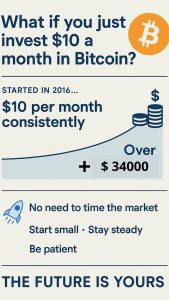Disclaimer: This is not investment advice. But if you stay out of the market for the next 15 years, you might forget this video, while your financial situation fails to keep up with inflation.
At 35, you already know something fundamental: money under the mattress is money that slowly dies. Inflation eats away your purchasing power while you sleep, and savings accounts at 0.5% interest are basically a mathematical insult. If you are like the 79% of Americans who haven’t touched crypto yet, this plan could change your financial future without ruining your present.
Here’s the statistical reality you need to know: 21% of American adults already own cryptocurrency. That’s 55 million people who made the decision before you. Among active crypto investors, 59.13% use dollar cost averaging (DCA) as their primary strategy.
Why? Because it eliminates the stress of trying to perfectly time a market that never sleeps.
What is DCA and why does it work?
Dollar cost averaging means investing a fixed amount regularly regardless of price. For example, $125 every month in Bitcoin, rain or shine. When the price is high, you buy fewer units; when it’s low, you buy more. The result is reducing your average acquisition cost and removing the stress of trying to predict unpredictable markets.
Recent studies show that DCA with Bitcoin can generate average returns of 12.33% over six-month periods, even in volatile markets, compared to leaving $125 monthly in a savings account at 0.5%. We’re talking about the difference between building real wealth or staying stuck.
Bitcoin: The Anchor of Your Strategy
Bitcoin isn’t just another crypto. It’s the digital asset with the greatest institutional adoption in history. Companies like Tesla, MicroStrategy, BlackRock, and Fidelity aren’t speculative firms; they are institutions managing trillions in assets that have validated Bitcoin as a store of value. With 67% of crypto owners planning to buy more in 2025 and institutions accumulating, the momentum is undeniable.
For those over 35, Bitcoin represents relative stability in the crypto world. Its network is the most secure, its adoption the broadest, and its narrative as digital gold increasingly accepted by the financial mainstream.
Utility Coins: Smart Diversification
Don’t put all your eggs in one digital basket. Utility coins like Ethereum (smart contracts), Solana (high-speed transactions), DeFi, and RWA tokens (real-world assets) offer exposure to specific sectors within the blockchain economy. Ethereum processes more value than Visa. Solana leads in transaction speed. RWA tokens bring real-world assets on-chain.
A suggested strategy could be:
-
60% Bitcoin for stability
-
25% Ethereum for proven utility
-
15% emerging utility coins for upside potential
This distribution provides crypto growth exposure without betting everything on speculation.

Advantages of Crypto DCA
-
Eliminates timing stress: You don’t need to be Warren Buffett to invest successfully. DCA automatically averages your entry price.
-
Builds automatic discipline: Investing becomes a habit, not a weekly emotional decision.
-
Reduces volatility impact: Peaks and valleys smooth out over time, decreasing psychological stress.
-
Scalability: You can start with $50 monthly and scale up to $500 or more as your financial situation improves.
Disadvantages You Should Consider
-
Opportunity cost: In a prolonged bull market, a lump sum investment might have yielded better returns.
-
Cumulative fees: Monthly trades can generate commissions that reduce net returns.
-
Lack of flexibility: A rigid DCA plan may prevent you from taking advantage of obvious market crashes to buy more.
-
Regulatory risk: Changes in legislation can affect the value of your holdings.
Learning Curve
Educate yourself progressively:
-
Months 1-2: Basic concepts, blockchain, wallets, exchanges
-
Months 3-4: Fundamental analysis, tokenomics, adoption metrics
-
Months 5-6: Risk management, portfolio allocation, security practices
You don’t need a PhD in cryptography, but you do need to understand what you’re buying. Dedicate about two hours weekly to education. Useful resources include YouTube channels, Coinbase Learn, and official project documentation.
Exchange vs. ETF vs. Self-Custody
Critical decisions await:
-
Exchanges like Coinbase or Kraken offer easy setup and automatic DCA but you do not control private keys.
-
ETFs offer maximum convenience within your traditional brokerage but charge annual fees and you don’t own the actual crypto.
-
Self-custody gives you total control and maximum security but requires technical knowledge and absolute responsibility.
Recommendation: Start with an established exchange and gradually move toward self-custody as your knowledge and holdings grow.
The Three Pillars of Real Diversification
Don’t be the person who puts 100% in crypto and then can’t sleep. Smart diversification includes:
-
Pillar 1: Cryptos — 10 to 20% of your total portfolio, providing digital future exposure without being your only bet.
-
Pillar 2: Stocks — 65 to 75%, including index funds, blue chips, and growth stocks, the proven growth engine.
-
Pillar 3: Bonds — 10 to 20%, offering stability, predictable income, and recession protection.
This structure lets you capture crypto upside without compromising your fundamental financial stability.
Practical Implementation Plan
-
Define your total monthly investment budget.
-
Allocate percentages to the three pillars.
-
Set up automatic DCA on a reliable exchange.
-
Review and rebalance quarterly.
-
Keep six months of expenses in an emergency fund outside of crypto.
Example: If you invest $500 monthly total, allocate $75 to crypto DCA, $350 to stocks, and $75 to bonds.
The key is consistency over perfection. Better to invest $50 monthly for 5 years than $5,000 once and then nothing more.
At 35 plus years old, you have something younger investors don’t: a long-term perspective and real investment capacity. Use those advantages.
The crypto train hasn’t left—it’s just arriving at the institutional station.
If you want, I can help tailor this further or prepare it for a specific format!
